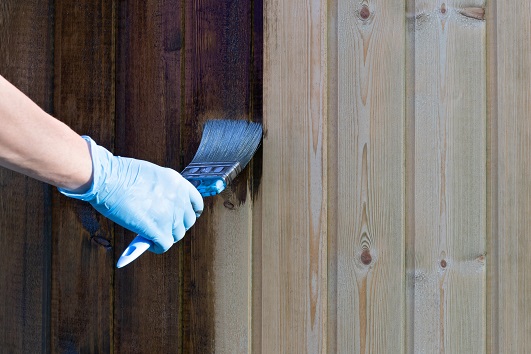
Decorators
Search

Decorators
Search

The season of garden makeovers is here! Whilst spring offered a chance to get started with those gardening jobs we’re all guilty of putting off, the pleasant weather conditions of summer, make ticking those to-dos off your list more of a pleasure than a chore.
A task that can transform the entire look and feel of your garden is painting your fencing. Our experienced, local painters offer their advice on doing the job right so you can enjoy every inch of your spruced up outdoor space this summer.
You’ll need a few supplies before you get started. These include your desired paint or stain, primer (optional), a large brush, step ladders (if necessary), pressure washer, soft bristled brush, sandpaper, protective sheeting, and gloves.
When choosing your paint, it’s not just the colour that you should consider. The paint you select should be specifically designed for use on fences. These specially formulated paint types are developed to withstand sun exposure, provide a weatherproof coating, and minimise fading caused by UV. Fence stains offer a great alternative that retain the natural beauty of the wood underneath.
Most fence paints are water-based; avoid using paints that contain silicone additives as these peel and chip with time.
As with any paint job, preparation makes perfect. Your fence will need repairing, sanding and pressure washing before it can be painted, particularly if it has already endured its fair share of paint jobs. Once sanded and fully dry, dust off the surface with a soft bristled brush.
The surrounding area should also be prepped. Trim back overhanging bushes, trees and shrubs to ensure there’s plenty of room for painting. If you’ve recently mowed your lawn, collect loose cuttings to prevent fly-aways from ruining your paintwork. Use protective sheeting to protect surrounding surfaces, garden décor and plant life.
Primers and other fence protectors are completely optional, in fact, many fence panels have already been treated to provide a certain level of rot and moisture protection. Many people however choose to apply primer to new fence panels.
You may want to use masking tape to protect brackets, latches and hinges before you begin. Apply your paint thinly and evenly with a large brush following the direction of the grain. Alternatively, you can use a paint sprayer for large fenced areas. Apply multiple coats as recommended for the paint type.
Avoid painting your fence in bright sunlight to prevent coats from drying too quickly. You should also paint during dry conditions. Don’t let your fence painting efforts go to waste, repeat every two to three years to keep your fence looking beautiful.
Does your fence need painting? Leave it to the professionals by using our tool to find a local decorator today.